If you ask me, a dark Cajun roux is the secret ingredient that is the single most important building block of Cajun cooking. So important, that for your convenience, we developed a jarred product we call Rox’s Roux–the deepest, darkest, and richest commercially available roux. This product will add consistency and quality to any Cajun roux-based recipe.
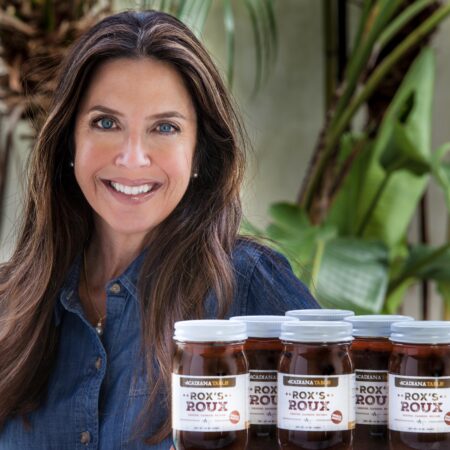
Roxanne Graham and her Rox’s Roux. (All photos credit: George Graham)
So, what’s all the fuss about a Cajun roux? To find out, we urge you to make a roux from scratch and discover the lost art of roux-making, a roots cooking technique essential to Cajun and Creole culture. My wife Roxanne will show you how in a step-by-step video that will give you every one of Rox’s roux-making secrets. Take a look by clicking below.
Making a dark Cajun roux from scratch is a dying art. Not too many years ago, there wasn’t a Cajun or Creole household in South Louisiana that didn’t have the unmistakably intense aroma of a dark roux, in all its glory, wafting through the kitchen. Home cooks were taught basic roux-making skills early on, and it was a rite of passage to pass it on to the next generation.
Times have changed.
With the proliferation of jarred and powdered roux products, as well as packaged gumbo mixes, the art of roux making is slowly dying off. Don’t get me wrong, some prepared roux products like Rox’s Roux are very good, and I use them myself. But, there is no substitute for the ritual of making a homemade roux from scratch, and I believe it is the obligation — no, responsibility — of roux makers to hand down this timeless artisan skill to their children. I know my wife has.
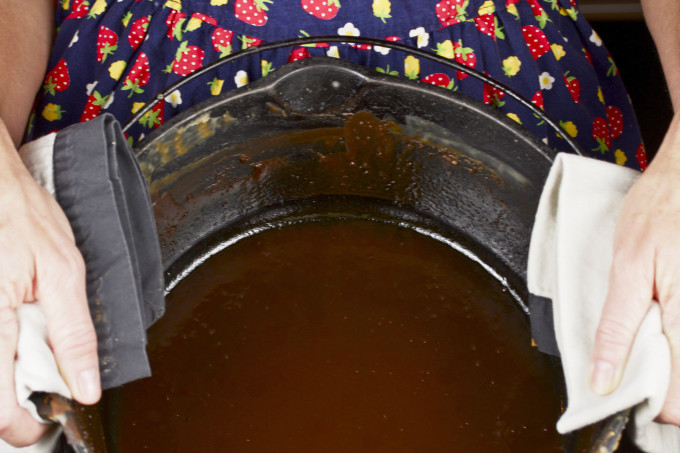
The dark abyss of a perfectly made Cajun roux is the depth of flavor in Rox’s Roux.
Rox can make a roux.
As deep and dark as blackstrap molasses and just as rich.
My wife Roxanne doesn’t cook every night nor does she profess to be a culinary artisan, but she is one of the best natural cooks I know. For her roux, she follows a strict set of guidelines handed down from generations of good Cajun cooks before her. She was born and raised in Jennings, Louisiana, and I sometimes tease her that her grandmother’s black iron pot and well-worn, wooden gumbo spoon were her dowry. Truth be told, to her they are significantly more valuable than anything money could buy.
On a cold January day, she can work magic in that pot with a roux-infused chicken and sausage gumbo like none other I’ve tasted. A roux is the foundation on which gumbo is based. Rox’s roux is nursed and nourished with a serious attention to detail that defies logic. It’s as if my wife goes into a semi-lucid state of consciousness that is mesmerizing. She stirs and stirs. And focuses on color, texture and smell. For over an hour, she stirs. No phone calls, no conversations, no distractions whatsoever.
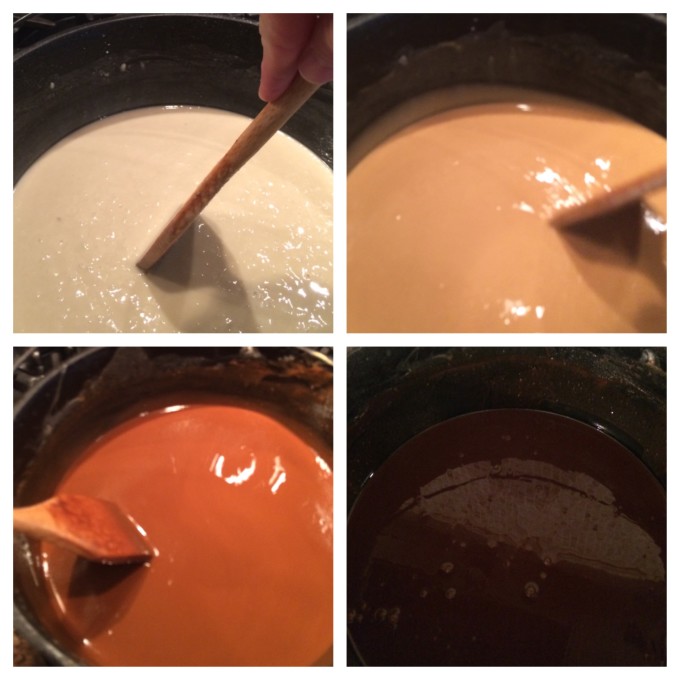
White, cream, beige, tan, brown, mahogany, and beyond.
There is an instinctive point of departure — a point of no return that she pushes beyond. A less brave or sure-handed cook would stop short of perfection. She has the confidence and courage to pursue that hauntingly dark depth of a rich chocolate-colored roux. Hershey bar chocolate is the terminus, and anything more is burnt and destined for the disposal.
With her wooden spoon scepter in her right hand, my gumbo queen rules the kitchen.
- 3 cups all-purpose flour
- 3 cups oil, such as vegetable oil
- A Cajun roux starts out in a large cast iron pot over medium heat. With no distractions and approximately one hour of time at your disposal, begin by adding the flour and oil.
- With a long-handled wooden spoon, begin to stir. Constant stirring and moving the flour around the bottom of the pot is the key to browning the flour evenly to prevent burning. This early stage will go slowly as you begin to see the white flour take on a beige and then a tan color.
- Continue stirring slowly and evenly, scraping the bottom and the circular crevices of the pot to move the flour around in the hot oil.
- At about the half-hour mark, you will begin to see a brown color developing and smell the first hints of toasted flour. This is where the stirring becomes even more crucial.
- At this point, you begin to enter the quickly developing phase where the least bit of inattention could result in burnt flecks of flour appearing – a sure sign you’ve ruined the roux. Watch your heat and lower it if the roux is cooking too fast.
- Constant stirring to keep the flour from staying in one place too long prevents burning. You will begin to smell an even nuttier aroma as you see the color turn darker mahogany. Most stop here, but you will keep going until you achieve a deeper, darker chocolatey consistency and color.
- Forget time at this point since you are now cooking by instinct, sight and smell. The utmost attention is needed to your stirring, and when you see that Hershey chocolate darkness, you will know you have arrived.
- Turn off the heat, but continue stirring until it begins to cool down and quits cooking.
- Spoon the roux into a bowl and let cool.
YOUR SEAT AT THE TABLE: If you like this Cajun cooking story and Cajun recipe then accept my personal invitation to subscribe by entering your email at the bottom or top right of this page. It’s quick, painless, and FREE. You will receive an email alert and be the first to see when new Cajun cooking stories and Cajun recipes are added. Thanks, George.
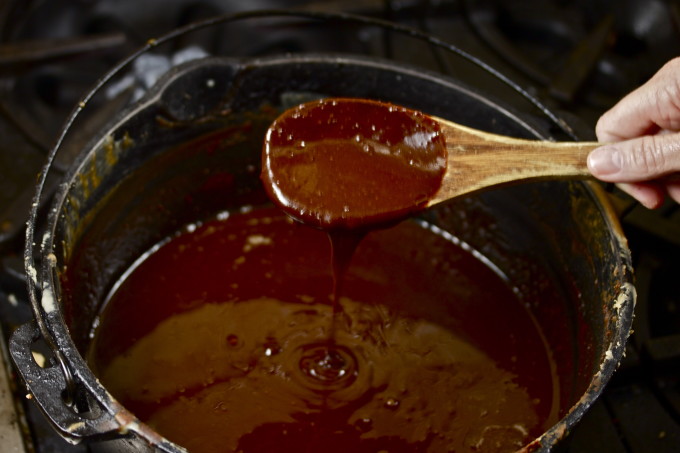
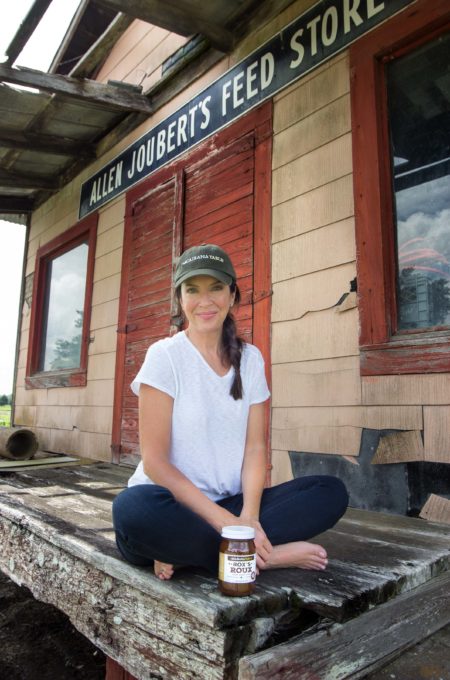
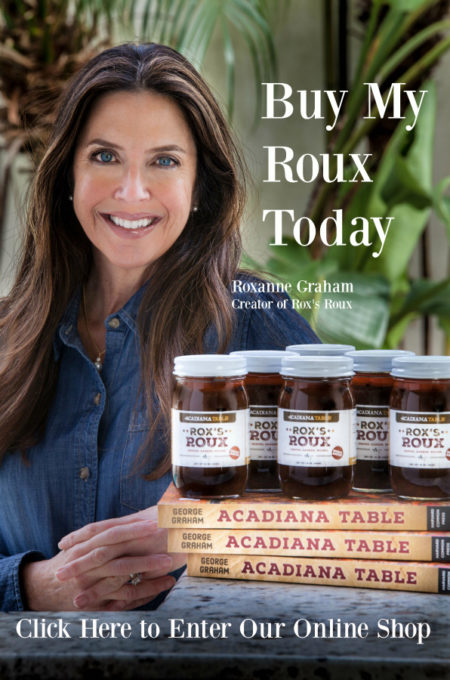
Just made my first dark roux (1:1 ratio) and it was on the thin sideafter it was done- except once I poured it in the storage container it started to settle on the bottom but the top layer was still thin but not separated. Is this how it’s supposed to be? I saw other videos of paste like roux and note I’m thinking I’ve made a mistake.
Yes
I just made my first roux with equal parts of coconut oil and almond flour. Your narrative is true. The dark chocolate color was the reward. It was the base of my first gumbo (chicken, andouille sausage and shrimp). It took hours to make and lots of dishes and pans, but my diners were very pleased. I plan to make it again.
Hey Eileen-
This keto-friendly version is interesting to those who embrace a low-carb diet. One question: Once it darkens, do you lose the coconut and almond flavors? Let us know. Thanks for the comment.
Thank U
How do you feel about lard for the fat?
Hey John – I like the way you think, but be sure to understand that pork lard is not a neutral flavor oil. For the right roux-based recipe it will be excellent, but I would not use it in some more delicate dishes like a seafood gumbo. By the way, in my travels I’ve run across only one store that sells jarred roux made with lard in Mowata, Louisiana called The Mowata Store. All the best.
Making a good roux should be learned by every cook.
I agree. I’ll add this: learning the stages of roux is essential to good cooking.
After all, the Bechamel, she is a mother sauce, no?
And without the white roux, what are we to do for cream or redeye gravy?
And as our roux blanc develops and she turns blonde, we now have the whole range of veloute.
And so on, as it becomes tan, and chestnut, and finally deepens into that lovely marron.
Absolutely beautiful roux mon amis, almost a cherry chocolate color. The recipe, too, simple and spoken plain. Merci beaucoup
Oui!
Bet lard was used by all of the original Cajun roux cooks. I’ve never lived in South Louisiana, I’m a North Louisiana redneck, but I’ve been married to a little Cajun girl from Eunice for over 56 years. I believe she may have made a roux once.. or, thrice.
Nolan – I bet you are correct, and I do know one store that still sells jarred roux made with pork lard. All the best.
Mine is foamy. What does this mean?
Polly- In the beginning stage, sometimes the flour and oil will become bubbly and frothy (foamy), but as it cooks and takes on a darker color, the mixture should cook down into a smooth texture. Give it another try and be sure to watch the video. All the best.
How to you reheat cold roux
Shene- Either cold or room temperature, roux is always added to liquid and dissolved over heat. Once it fully melts into the the stock or water it will work its flavor and thickening magic. All the best.
Just got back from New Orleans yesterday. I decided to make gumbo for the kids. I’ve made many a roux in my day but never a dark Cajun roux. It looks like smooth melted chocolate. I used 1/2 bacon fat and 1/2 light olive oil. Roux cooked for about an hour or so. Now to add the trinity and some chicken & shrimp with some homemade shrimp stock. Thanks for the tips. Should be delicious!!!!
How much of Rox’s Roux will I need to make 4 gallons of gumbo? Also, do I mix the jarred roux with some stock before adding it into the gumbo or just scoop out a certain amount and add it to the gumbo? Trying her roux for the first time as I am a little short on time and this will really help!
Hey Jonzey – Roux is not an exact science, but based on 2 tablespoons of roux per quart of liquid, my estimation is 2 cups of roux by volume or 1 16-ounce jar of Rox’s Roux. This should make a gumbo of medium thickness, so if you like it thicker, add more roux. All the best.
Do you use/keep the oil from the top of the jar or discard it?
John – Really good question that prompts a discussion for the many folks out there that are new to roux. When molten-hot Rox’s Roux is first poured into a glass Mason-type jar, the heat seals the lid once it is screwed into place; this ensures that your jar of roux will keep safe for months or up to 3 years if unopened. As the roux cools in the jar, the oil rises to the top which adds an additional “seal” for the cooked flour underneath. This is all a natural and normal process, and not a “separated” roux as some might think.
Now on to the question of what to do with the oil: There is flavor in the oil, and if I am using the whole jar of roux, I like to pour the oil into my pot to saute my trinity (onions, celery, bell pepper) as I begin making my gumbo. However, if I am only using some of the jar, I will spoon out my roux and leave the oil to coat the top of the remaining roux in the jar for safe-keeping. With the screw-top tightly back in place, the jar of leftover roux will keep for months at room temperature, or some folks prefer to place it on the door of the refrigerator or even the freezer–all good.
I hope this answers your question, and I wish you all the best.
Thank you for the reply, looks like I ordered in January 2018, so I need to get to making some gumbo quick!
I love making Shrimp & Crab Gumbo! Yes, it does take some time to make a chocolate roux, but with a nice glass of wine & good listening music it’s worth the time invested!
This was a fabulous article! I love making a roux as it is a soulful endeavor.
Bobby D’Roux
Hey Bobby – I thank you and my wife thanks you. We urge you to pass on this skill to the next generation of rouxmakers. All the best.
Great post. I’m still trying to get there with the Roux. I usually settle for dark Carmel color
Hello, this is my first time reading any of your posts. I’m Mary from Baton Rouge, LA out of a small English parish called East Feliciana. Most of my people are Creole mix, and I grew up on the the red gravy roux. I loved it until I met my husband who is from a Cajun background, and I changed to the dark roux. Now, I love it. The problem is, I’m 65 and the only roux-maker left in the family. My children and grandchildren will not take the time to learn how to make a true, rich roux, and they always want me to make the gumbo. I am getting old and refuse to do it, so I will recommend Rox’s Roux.
Hey Mary- Thanks so much for this great comment. So glad you are recommending Rox’s Roux to them, and I believe that jarred roux has a place in every family’s pantry. That said, I do hope that you will attempt to teach them to make a roux. Passing these traditions and culinary skills to the next generation is the only way to keep our culture alive. All my best to you and your family.
I bought the Acadiana Table cookbook a couple of years ago and have been working through the recipes. Many bring back memories of the best meals I’ve ever eaten, those prepared by my grandmother. We are from a French family who came through Charleston, and over the centuries, dropped off in AL, MS, LA, and TX. Tried several jarred rouxs and hated them. However Rox’s Roux is amazing and has become a staple in our larder. Keep up all of y’all’s good work helping us foodies satisfy our obsessions!
Hey Walter- Thanks for the beautiful comment. Like you, we are passionate about our culinary heritage and want others to share our treasure of delicious recipes. It is reassuring to hear from folks like you that appreciate Louisiana food. All the best.
Hello!
Just made the roux and color is a perfect chocolate color but it does not have a thick consistency. What should completed consistency be at the end of cooking and prior to cooling down?
Hey Freida- The roux will thicken as it cools. Once finished cooking, add it to a glass Mason jar with a screw-top lid. It will solidify as it reaches room temperature. The oil will rise to the top, and when you open it to make your gumbo, you can either pour off the grease or use it to saute your onions. Spoon out the roux and store the remaining roux either in your pantry or your refrigerator. All the best.
Hey There! I usually use Kary’s Roux. One big jar which is 16oz and maybe a half of a small jar. How many cups of flour and oil do I use to make this quantity? Thank You so much. I wanna make my own roux. I like a medium-thick roux for my gumbos!
Hey Eddie- Here is what I would do: Use 4 cups of flour to 4 cups of oil. This will make more than enough roux for your gumbo and give you extra for the next one. Store in a glass Mason jar and it will keep at room temperature or in the refrigerator indefinitely (up to 3 years). All the best.
I grew up in Orange, TX, and my grandmother grew up south of Abbeville (basically marsh) and spoke Cajun French. I stumbled across this website, and I can tell everyone here that this recipe among others is holy sacred and the Internet is lucky to be provided this valuable information.
I’ll add something to make the process a little easier. My grandmother used to tell us to have a Ms. Butterworth bottle out, and when cooking your roux, pull it when it’s the color of the bottle. My grandmother didn’t drink, so I use a Shiner bock or Abita. When it’s that dark beautiful color, pull it!
Thomas – I love this colorful story about your grandmother. You have strong Cajun roots to be proud of. All the best.
I agree with using something as a color guide. I taught my sons to make roux using peanut butter (not dark enough) and a Hershey bar (just the right color). I live in SW Louisiana and work in Orange, TX. Good people and good food!
I’m a North Carolina guy who has loved and made Cajun/Creole dishes for decades now, constantly improving all the while. We recently took a whirlwind trip to NOLA/Lafayette, and despite the long drive, had a wonderful time and came home with coolers loaded. I’ve made roux traditionally for years but have recently switched to the oven method. I start it conventionally then bake it at about 350ºF, stirring every 15-20 minutes or so until I reach the variant I’m after. The results have been very good, even for dark roux. It takes longer but frees me up for other things. I wonder if I may solicit your opinion on this.
Hey Eric- The oven method is quite common these days among home cooks and restaurant chefs alike. Chefs like for the very reason you mentioned; it frees them up in the kitchen. Some folks will even go the oven method to make a dry roux (no oil). There are no wrong ways to make a roux, as long as you arrive at a deep, dark, rich result. All the best.
I made my roux using 3 cups flour to 3 cups peanut oil. It never got thick at all, but remained really oily. But I was able to get a really dark chocolate color without burning it. I am hoping it will thicken, as it would really make an oily gumbo. I will see how it looks tomorrow before I make my gumbo. Any reason why it stayed oily?
Kay- Your roux should be fine; just pour it into a glass jar or container. Hot roux has an oily “sheen” that goes away as it cools. For instance, if you buy any jarred roux, you will see a layer of oil at the top of the jar; this is natural. As cooked flour settles in the jar, any excess oil will rise to the top. Pour it off and spoon out the roux. Happy cooking!
Am new to roux, but have the assistance of Miss Shirley Kaye and Miss Connie Jo to help. Working on an Oyster Stew recipe that calls for sweating the onions and celery in the roux. It ends up in a sticky glob. So far, I’m thinning the roux with oyster liquor and/or vegetable stock to get the job done. The results are good, but do i need more liquid in the roux to begin with? I’m using equal parts flour and oil.
George-
In my experience, an oyster stew is a delicate dish featuring aromatic vegetables (diced onions and celery are perfect), seasonings (I use white pepper, salt and a dash of hot sauce), oyster liquor and/or stock (I use seafood stock or clam juice), and just the perfect amount of light roux to thicken this base before introducing the oysters at the last minute. Our Rox’s Roux recipe is for making a deep, dark Cajun roux which would overpower this dish and is more suited for heavier gumbos and stews. Instead, make a blonde roux by combining the flour and oil (or butter) and cook just until it begins to take on a tan color. Add this to your pot, and it will thicken once it comes to a boil. You will have to play with the liquid/roux ratio to get the consistency you want, and be sure to add your oysters just before serving and cook just until the edges curl. Bon Appetit!
I am yet to try this but I am excited to put my hand to the test.
We have lived in many places, and Lake Charles was one. Now in NC. We fell in love with the food there and had many friends and they were such good cooks. They taught me lots of Cajun recipes. So thankful! I am making gumbo on Christmas and always make my own roux with the 1-1 ratio and love it. We are not fond of Creole and seems like that is the only kind found in our restaurants, so I make the good ol’ Cajun gumbo a couple times a year. When I mention anything Cajun, my family are all in for it. Thank you for this site. Was looking to try a bought roux but talked me into making it. I am 76 and no one in my family will carry on my “cook from scratch” methods. Sad.
Delighted to find someone actively promoting the art of homemade roux! Having grown up and lived my life about an hour east of New Orleans, I’ve made roux for over 50 years but I’ve always used a 1:1 ratio by weight rather than volume, as did my New Orleansian grandmother. By this method, 1 cup of oil (or shortening, as she used) requires about 1-3/4 cup flour, or 4 cups oil to 7 cups flour. Cooks exactly the same but less oily; it still settles some but there’s only a skim of oil on the top. Roux made 1:1 by volume seem very thin and greasy to me when freshly made so I’ve never made a large enough batch to store it. Perhaps considering it both cooking oil and roux it makes sense, but I’ll stick to my weight-based ratio!
Hey Judi- I like your thought process here, and I will give your ratio a try. Thanks for a well-worded comment.
My dad is originally from Mississippi. It’s one hour from Nola. When we were younger traveling there for holidays and summers, we ALWAYS made the trip or two to Nola. So I learned to make gumbo in a hot Creole kitchen. I seldomly make it because crafting roux takes so long. Now that I know I can store it in jars, I will do so more often. My kids love my gumbo, but none know how to make roux. My next dilemma is the rice I used to use for gumbo before Katrina struck; I haven’t seen it since. It’s called Creole Rose. Any idea if it’s around anymore? I will be headed that way in Spring of 2021 if this pandemic clears up.
Hey YaYa- Glad to hear from you. I am not familiar with the Creole Rose brand of rice, but with a quick Google search, I see that it is made by Garber Farms near Iota, LA. Not sure where they distribute it, but you might want to contact them to get store location information. All the best.
Thank you for this rice information. My relatives live in Iota so I will check with them. Do you by any chance make and sell a gluten free roux? I make my own with GF flour and no one can tell the difference in taste. I would love to have pre-made. Thanks.
Hey Ladonna- We do not make a gluten free roux, but I have seen a couple of brands at Champagne’s in Lafayette’s Oil Center and at Fresh Picken’s market in Lafayette. All the best and happy cooking!
Would love to get your email and any info on gumbo and other Cajun dishes for this transplanted Kentwood, Louisiana native.
Hey Jackie- Please sign up by entering your email address in the “Subscribe for Free” at the bottom of the page. You’ll receive weekly updates when new stories and recipes are posted. Thanks.
Just made this recipe! I’ve made roux many times, but was always nervous to go all the way dark. It came out great! My shoulder is tired but dang it looks good. Gumbo on stove now. Love your website! Thank you!
Ok, I been trying to teach myself to cook from scratch for about a half year now, and my girls tolerate most of what I create. I’m going to jump into Cajun recipes with both feet, because of all styles of cooking, the best flavor for me comes from the Deep South (Kansas City style BBQ is the only food that comes close). My question is about the cast-iron cookware and it’s importance when creating roux. I only have a glass-top stove, so cast iron is not likely to be used. What is the best alternative?
Hey Eddie- The reason for cast-iron is heat induction and the ability for the pot to hold even heat distribution. That lessens the potential for the roux to burn during the long cooking process. I believe that you can use a cast-iron pot or skillet on glass-top surface, but if not, I would select a heavy-gauge stainless steel pot or deep-sided skillet. The key, as always, is to monitor your heat and stir constantly. All the best.
Hey George, l live in Waxahachie TX, a Sulphur, Louisiana transplant. My mom has gone to cook gumbo for the Lord. Left me a Jude W. Theriot cookbook (La Cuisine Cajun). His gumbo roux takes about 3 minutes. That is the roux I make with equal parts flour and oil, but I will try the 1 hour roux; it sounds very good. Your website comments sure took me back. Thanks.
Hey Mack – Great to hear from all my Texas friends who grew up in Louisiana. There are many ways to make a roux, but the key is to do it consistently. I find that to get to a deep dark roux, I need to carefully control the outcome. Stirring gives me that control. All the best.
Hi George, greetings from Costa Rica, Central America. My first time preparing your dark Cajun roux. My wife does not eat wheat flour, she is allergic, so I made your recipe with gluten free flour. For some reason it took me two hours to get the dark color, but I made it. My plan is to cook the Cajun Seafood Gumbo. Thanks for sharing your recipes.
Is it not true that the longer a roux is cooked, it decreases the thickening power…?
Jeffrey-
I have never heard that, and I would be suspect of its accuracy. Roux is flour and oil and cooking it does not reduce the thickening power of the flour.
All the best.